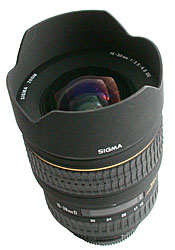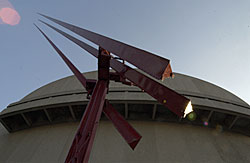Sigma
AF 15-30mm f/3.5-4.5 EX DG |
||||||||||||||
| A really wide angle zoom targeted at digital users.
The BasicsWhen Sigma quietly introduced this wide angle lens in Japan, the grapevine quickly brought word of it long before it showed up in US stores. The 1.5x angle of view multiplier built into the Nikon bodies has digital SLR users craving for wide angle support, and almost every D1 photographer I know has both the Nikon 14mm f/2.8 and the 17-35mm f/2.8 AF-S. Yet they still feel constrained at the wide end. Thus, a zoom that filled the gap at the wide end was widely welcomed. Sigma has been making high quality, unusual optics for some time. One of my earliest non-Nikon purchases was the 14mm f/3.5 (now replaced in Sigma's lineup by an almost identical lens that has a larger maximum aperture of f/2.8). And I used the 17-35mm Sigma for a brief time before passing it on to my mother. I knew I'd be looking at the 15-30mm the minute I heard about it. This lens has a maximum f/3.5 aperture at 15mm, f/4.5 at 30mm. The minimum aperture is f/22 at 15mm and almost f/32 at 30mm. Focusing reaches as close as 11.8 inches (0.3m). Depth of field markings are provided for f/5.6, f/8, f/11, and f/16. The design has 17 elements in 13 groups, at least one of which is aspherical. The front element does not move during focus changes, though this doesn't do you any good, since it sticks out like the bottom end of a plastic cola bottle and doesn't accept screw-in filters. A built-in "flower hood" attempts to block off extraneous light, but don't count on it--the front element curvature is so extreme that the middle of the lens is extremely prone to catching extraneous light.
Some Sigma dealers advertise the lens as taking 82mm filters. This is misleading. The lens cap consists of two pieces, a ring and a cap to the ring. The front of the ring has 82mm threads, and if you're using a digital SLR and aren't zoomed out to 15mm, you can leave the ring on the lens and screw a filter into it. But vignetting occurs even on the D1 at the widest focal lengths, and at virtually all focal lengths on a 35mm body if you put a filter on the front. (There is also a small "slot" at the rear that can be used to slip in thin gelatin filters cut to size.) The focus ring is wide, but uses the same rubber pattern as the zoom ring, which is narrower and close to the back of the lens. By feel alone you can't distinguish between them, but it's not a big deal. At over a pound (1 pound 6 ounces), this is a substantial lens. It's also quite large (almost 6 inches front to back and about 3.5 inches in diameter). The size and weight tends to surprise most people, as they seem to expect something smaller, especially when they hear that the lens has a variable f/3.5-4.5 maximum aperture.
HandlingI really doubt you'll be manually focusing this lens other than setting hyperfocal distance--you get almost no benefit from focusing manually due to the huge depth of field (which is approximately 1.25 feet to infinity at f/16!)--but if you do, you'll find the action quite stiff. The lens is put into manual focus by pulling the focus ring backwards towards the camera body, and this action is somewhat "reluctant" on my sample. Autofocus on my N90s, F100, F5, and D1x is reasonably fast, but slower than the Nikkor 17-35mm f/2.8 AF-S. I've never seen the lens hunt on autofocus. The focusing is quiet, but not "silent wave" quiet. The aperture ring is very nice, about the best I've felt on a Sigma. Click stops are definite, but you can easily set almost an infinite set of intermediary settings. The front element is very significantly exposed, so you're going to get fingerprints on this beauty if you aren't careful.
PerformancePerformance is a mixed bag. From a sharpness and contrast standpoint, the lens does a quite fine job. On a 35mm body, there's visible softening of the corners wide open, and the lens starts to show softness again (diffraction caused?) at very small apertures (f/22 and higher). In the mid-range apertures the lens is pretty darn sharp from corner to corner. On a D1x, the lens is sharp at everything but the widest and smallest apertures. Given Sigma's excellent performance with previous wide angles, I expected no rectilinear distortion. After all, the 14mm renders pretty darn straight lines, even when you place them at the frame edges of a 35mm body. Unfortunately, at 15mm this zoom shows significant barrel distortion even on a D1x (I haven't done any architectural work with a 35mm body and this lens, but I would expect the same). What's "significant?" It might be as much as 2 percent on a D1, slightly higher on a 35mm body. I fully expected light falloff in the corners, but this common wide-angle problem is fairly well controlled on this lens except at the maximum aperture. What little falloff there is I find pleasing enough not to be bothered by it. And most of the falloff is at the very edges, so D1 users won't see much, at all. But...the extreme front element curvature produces a penalty you need to be aware of: flare. If any stray light hits that big hunk of glass, contrast is greatly reduced, making most images unusable. Worse still, direct hits of light on the element sometimes produce a strange bit of flare--essentially a hot spot in your image (the depth of field is so great at smaller apertures and close focus distances, that at times it can be at the front element, meaning the light hitting the lens is rendered in the image!). This isn't just a matter of sun being in the frame. On my D1x, any hot spot that is rendered "beyond white" has a tendency to produce a flare spot.
|
| Quick Evaluation |
|
| Table of Contents |
|


